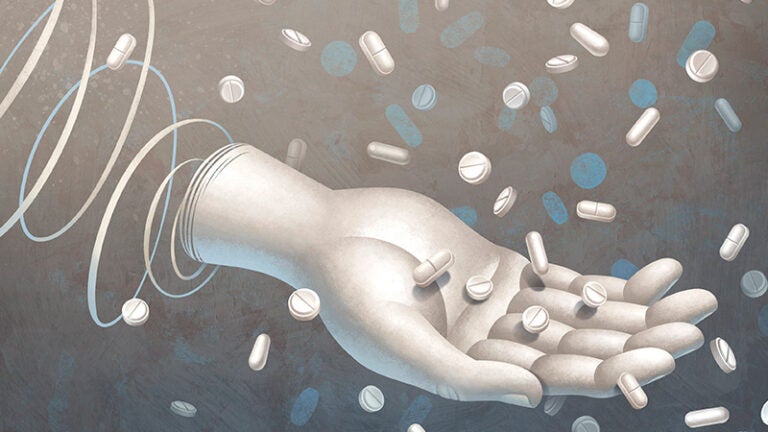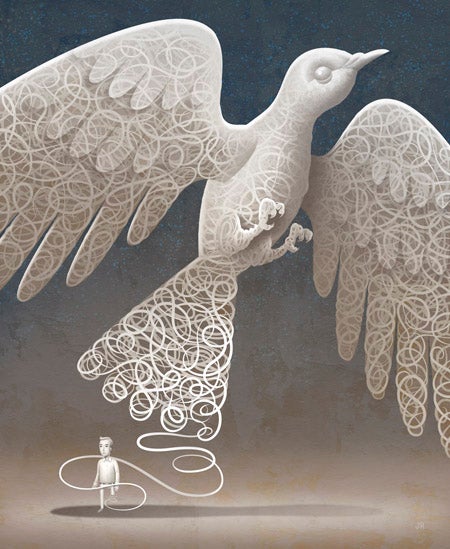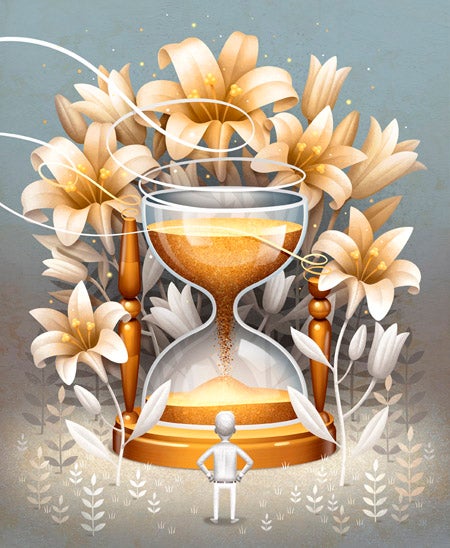
Hanging by a Thread?
Start tugging at a thread and you never know what will unravel.
Economists Angus Deaton and Anne Case understand this all too well. Three years ago, they began pulling statistics for a study on happiness. The two researchers were curious to see how data about people’s happiness lined up with instances of suicide. Surprisingly, they found that suicides for middle-aged men and women were on the rise. So they plucked on the thread a little harder.
Deaton, a Nobel Prize winner and Presidential Professor of Economics at USC Dornsife, and Case of Princeton University gathered data from the Centers for Disease Control and Prevention on all-cause mortality rates, aiming for a broader picture. They made another startling discovery: Since the late 1990s, the death rate for white, non-Hispanic men and women in their 40s and 50s was climbing, reversing a century-long downward trend.
The bulk of cases were from drug overdoses, suicides and alcohol-related liver disease — “deaths of despair” as the researchers came to call them — and not the usual suspects like cancer and heart disease. The mortality rates were highest and rising most rapidly for those with a high school degree or less.
From 1978 to 1998, the mortality rate for white men and women age 45 to 54 fell on average by 2 percent each year. That matched the average decreases in mortality rates for Hispanic and black Americans, as well as those of residents of other wealthy countries such as France, Germany, the United Kingdom, Canada, Australia, and Sweden. Then, in 1998, the mortality rate began to veer upward for midlife white American men and women without a college degree.
What was going on?
First, let’s step back 250 years.
Deaton, who is known for his research into poverty, inequality, health and well-being, argues that around 1750, the world began to get better for almost everyone.
In his book The Great Escape: Health, Wealth, and the Origins of Inequality (Princeton University Press, 2013), Deaton traces the upward trajectory of society from a time when poverty and low life expectancy were pervasive, to the present, when most people lead healthier and wealthier lives.
Specifically, Deaton pinpoints the Enlightenment as a watershed after which people sought out ways to improve their lives by gaining a better understanding of the world around them. This led to the development of medicines and other treatments for diseases, and eventually vaccines for common deadly ailments. Those, plus safer medical practices, readily available nutritious foods, clean water and improved sanitation, resulted in longer lifespans.
“So you can imagine how surprised I certainly was by this recent turnaround, which seemed like a long-term reversal,” Deaton said.

For the first time in a century, the death rate for midlife white Americans without a college degree is on the rise, but the usual suspects like heart disease and cancer are not to blame. Instead, drug overdoses, suicides and alcohol-related liver disease are causing these “deaths of despair.”
In truth, the numbers had been hiding in plain sight for some time. The CDC had been reporting on the uptick in deaths for this group, but those reports were released piecemeal as data became available. It wasn’t until Deaton and Case went searching for all-cause mortality numbers that they put the puzzle pieces together and shared their findings.
“The New York Times was calling us every day asking, ‘Can we put your chart on the front page?’ And we said not until we get it published somewhere,” Deaton said.
Their initial findings were published in a brief but influential paper in the Proceedings of the National Academy of Sciences. (Soon after, they did land that cover story in the Times).
Just a few weeks prior to the paper’s publication, Deaton was named the 2015 Nobel laureate in economic sciences for his work studying consumption, poverty and welfare. Deaton’s prestigious accolade and the powerful study findings garnered an avalanche of media attention.
While it’s still unclear exactly why mortality rates are on the rise for midlife white Americans without a college education, Deaton and Case have found a thread connecting their experiences. This group has seen their economic and social well-being diminish. Their median earnings have decreased and job prospects have dwindled. Meanwhile, they report higher prevalence of physical pain and mental health problems, as well as fewer ties to supportive social structures such as religion and marriage. Their challenges are further fueled by the escalating opioid epidemic in the United States.
“Life has not been so good for these people for the last 40 years or so,” Deaton said.
The death of the blue-collar aristocracy
In the 1980s, fourth-generation autoworker Ben Hamper was in his 30s. He had been laid off from General Motors manufacturing jobs five times in five years. Expecting to be laid off again due to the company’s downsizing, he suffered a panic attack that forced him to leave his post on a GM assembly line mid-shift.
Hamper’s plight is recounted in Roger and Me, Michael Moore’s 1989 documentary film chronicling Moore’s attempts to meet with GM’s then-CEO Roger Smith, who had closed a number of auto plants in Flint, Mich., laying off thousands of employees.
Hamper, who meets with Moore on-camera at a mental health facility where he is receiving treatment, describes how he retreated to his car during the panic attack. Buoyant lyrics from the Beach Boys’ “Wouldn’t It Be Nice” resounded from his speakers: Maybe if we think and wish and hope and pray it might come true. Baby, then there wouldn’t be a single thing we couldn’t do.
But in that moment, without prospects for the future, any optimism Hamper had was gone. “I was just trying to rationalize with those lyrics, just trying to think ‘Wouldn’t it be nice?’ and it just wasn’t working,” he told Moore.
For much of the 20th century, the best blue-collar jobs offered a steady and secure route to the middle class. People who entered the labor force out of high school could expect to find well-paying jobs with a clear path for advancement.
“They belonged to a union, they had pay raises ahead of them. They could build a middle-class life, have a home, a car. They could get married and have kids,” Deaton said.
But now those jobs exist in far fewer numbers. Working-class wages hit a pinnacle in the 1970s, explained Deaton, but that marked the beginning of the end of the “blue-collar aristocracy.” Jobs have been moving overseas, wages are declining and, above all, automation is replacing workers, meaning fewer job opportunities and increased poverty.
“So what’s happened is that life has come up hard, especially for those who don’t have a university degree,” said Deaton.
“Today a person dies from prescription opioid poisoning every 29 minutes. Annual opioid sales are enough to keep every American on opioids around the clock for one month.”For middle-aged white Americans, those economic hardships translate to instability in other areas of their lives.
Lower wages for men, for instance, make them less desirable marriage partners. As a result, they are less likely to marry and instead cohabitate with their partners. Meanwhile, evolving mores have made it more socially acceptable for unmarried couples to have children. However, cohabitating relationships are less stable than marriages and often do not last.
“One statistic that really blew me away was that the majority of white mothers in America had at least one child out of wedlock,” Deaton said. “And then you get children who have had three or four different ‘dads’ by the time they’re teenagers.
“So you can imagine, you’re a working-class guy with a high school degree but no university degree. And instead of getting the nice union job in the steelworks that your dad or grandfather had, you’ve moved around from one short-term job to another. You’ve had a couple of kids, but you don’t know them anymore because they live with another guy. You’ve never settled down to a stable marriage or a stable job. And as you get into your mid-50s, life looks pretty bleak.”
John Monterosso, associate professor of psychology at USC Dornsife, studies decision making and addiction. As he explains it, being part of a community is an important factor in our well-being. People need others to depend on them whether it is to show up and do a job or as part of a relationship.
“People need obligations and purpose,” Monterosso said. They give people meaning and structure in their lives.
The stress of life not turning out as planned combined with additional hardships for this group have led to risky behaviors that have put many on the path to alcohol and drug use, with severe consequences.
Dulling the pain
In the course of their research, Deaton and Case also discovered that the increasing mortality for white men and women age 45 to 54 was matched by increasing illness.
Beginning in the mid-1990s, middle-aged whites began to report more incidences of pain — joint pain, neck pain, sciatica, it runs the gamut — as well as more mental distress, according to the CDC.
Around the same time, opioids became a popular way for doctors to treat pain, explains behavioral scientist Joan Broderick, associate director of the Center for Self-Report Science at USC Dornsife’s Center for Economic and Social Research.
Previously, chronic pain was primarily treated by teams of occupational and physical therapists, social workers, physicians and psychologists. Treatments would take place over several months and they would be tailored to a patient’s needs, using different therapies such as exercise, biofeedback and stress reduction.
While that model was effective, it was also expensive. Doctors shifted toward pharmaceutical therapies, which were quicker to administer and showed promising results for palliative care patients in hospice. The problem was that these physicians failed to observe any dependence on these highly addictive medicines — mostly because their patients did not live long enough to exhibit any.

Community efforts, coupled with action from policymakers and practitioners, will be key to stopping the rising rates of midlife mortality of middle-class white Americans with less than a college degree, argues study co-author Angus Deaton.
“They wanted to be merciful and bring the same treatment to patients who had chronic pain and perhaps many more years of life ahead them,” Broderick said. “So it was all with good intentions, but there was insufficient evidence to support it.”
In recent years, the U.S. opioid epidemic has ballooned. “Today a person dies from prescription opioid poisoning every 29 minutes,” Broderick said. “Annual opioid sales are enough to keep every American on opioids around the clock for one month.”
And unfortunately, many people who suffer from pain are turning to the streets, where drugs like heroin are readily available and cheaper than prescription medications. Some patients also turn to alcohol or even suicide.
Broderick, who studies pain management techniques, offers a path toward pill-free pain treatments. She has developed the Pain Coping Skills Training program, a special regimen of strategies that health practitioners teach their chronic pain patients. With this approach they coach patients on progressive-muscular relaxation methods, guided imagery, activity pacing, distraction techniques and other problem-solving strategies patients can use both to stave off flare ups and deal with them when they happen.
A matter of choice and control
Another common thread for white Americans dying in midlife is their level of education. More often than not, they have achieved, at most, an associate degree from a community college. Could their rising mortality rates somehow be connected?
People with more education tend to earn more money and have more power to shape their lives while those who earn less have less control, said Daphna Oyserman, Dean’s Professor of Psychology, and professor of psychology, education and communication.
“So, for instance, if you work hourly and you don’t have a set schedule, that makes it harder for you to manage your budget and your family. That sense of uncertainty then trickles down to your kids. It’s also harder to invest in a long-term strategy for yourself and your family when the long term is highly uncertain.”
Low levels of education can also influence successive generations. Oyserman, who co-directs the USC Dornsife Mind and Society Center, notes that a mother’s education is a predictor of the level of education her child will achieve, which in turn affects her child’s potential income. Societies with higher levels of education are also typically better functioning, and are associated with more civic engagement, less crime and more stable families, Oyserman said.
Oyserman’s research focuses on how small shifts in a person’s mindset can have a meaningful influence on their behaviors. Specifically, she studies ways to close racial, ethnic and social-class gaps in academic achievement and health.
Her 12-week School-to-Jobs program helps disadvantaged students create plans to accomplish their goals and to help them accept and believe that “someone like me” can reach their target. They are guided to form a mental image of adulthood, identify concrete steps to achieve their objectives and discuss any concerns they might have.
So far, the program has been successfully implemented in Detroit and Chicago middle schools as well as schools in Singapore. Students who participated in School-to-Jobs earned better grades, were less likely to have unexcused absences, saw their standardized test scores rise and reported that they spent more time on homework. Oyserman is now scaling up the program in other U.S. schools through teacher training programs and by developing websites and other digital platforms to deliver the intervention.
She has also proposed health-care interventions that tap into a person’s identity to tackle the health issues that are plaguing midlife white Americans.
In the journal Behavioral Science & Policy, she lays out recommendations that include designing public health campaigns that target a person’s identity, tailoring health treatments to individuals and making sure doctors and nurses explain how the information they gather from patients will help them. To incentivize these techniques, she suggests insurance companies reimburse doctors for using them.
“If solutions are going to get into schools, the medical community and elsewhere then it’s going to have to come from the grassroots up.”Beyond creating interventions and public health campaigns, Oyserman says that public policies can also have a powerful effect on well-being. This is especially significant right now as politicians in the U.S. debate how to deliver health care, for instance.
Withholding or providing health care communicates an idea about a person’s future and his or her potential worth that has both an economic and a psychological impact, she explained.
“Someone saying, ‘I’m going to invest in you because I think you have a future’ is quite powerful.”
Progress and Inequality
In The Great Escape, Deaton explains that with progress comes greater divides in society. The Industrial Revolution, for example, delivered technologies like the railroads, mining and agriculture to the West while the East fell far behind, though that is no longer entirely the case. Today’s global inequality, Deaton argues, is, to a large extent, the result of modern economic growth. With more technology, advances in health care and other breakthroughs, the distribution of goods is less evenly meted out. So as certain groups escape material deprivation, others are left behind. That is part of the challenge for midlife whites.
The collapse of the white working class after its heyday in the 1970s, compounded by social and health challenges, contributes to the deaths of despair that he and Case have been tracking.
So how can we overcome the pain, drug use, alcoholism and suicides that are swelling mortality rates of middle-aged whites?
Deaton says there is not one solution. But, he sees power in efforts that begin at the community level.
“If solutions are going to get into schools, the medical community and elsewhere,” Deaton said, “then it’s going to have to come from the grassroots up.”
Mothers Against Drunk Driving, for instance, made huge strides changing laws that sharply curbed deaths caused by drunk driving. Public health campaigns dramatically reduced the number of deaths from cigarette smoking. And, interventions like Broderick’s drug-free regimen to alleviate pain and Oyserman’s School-to-Jobs program are approaches that are already beginning to see positive results.
Deaton believes getting more people to achieve higher levels of education may not necessarily be the solution on its own, as not all people aspire to it. But in addition to helping those who do want more education, he suggests focusing on training people for the 21st century labor force.
He and Case are sharing their findings and expertise far and wide to ensure that as many people who can help, such as policymakers and practitioners, understand what may be contributing to the problem and what they can do. For instance, Deaton recently testified before a joint congressional panel examining the opioid crisis and other forms of drug abuse, and their possible relationship to economic factors.
And while Deaton and Case are still far from a smoking gun, they intend to continue exploring the underlying causes of these deaths of despair in more depth. How policymakers and practitioners act now will determine how quickly we can reverse the trend.
But over the long term, Deaton is optimistic. Society, on the whole, is still on an upward trajectory, he said. While there has mostly been exponential progress since 1750, there have also been periods of regression. The current situation, he hopes and believes, is just another of these periods.
Read more stories from USC Dornsife Magazine’s Fall 2017-Winter 2018 issue >>